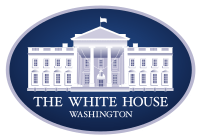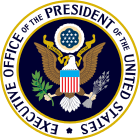White House Fellows
The White House Fellows program is a federal fellowship program established via Executive Order by President of the United States Lyndon B. Johnson in October 1964, based upon a suggestion from John W. Gardner, who would eventually become the 6th Secretary of Health, Education, and Welfare.[1] The mission of the program is "to give the Fellows first hand, high-level experience with the workings of the federal government and to increase their sense of participation in national affairs." President Johnson expected the Fellows to 'repay that privilege' when they left by 'continuing to work as private citizens on their public agendas.' He hoped that the Fellows would contribute to the nation as future leaders.
White House Fellows typically spend a year working as full-time, paid special assistants to senior White House Staff, the Vice President, Cabinet Secretaries and other top-ranking government officials. Fellows also participate in an education program consisting of roundtable discussions with renowned leaders from the private and public sectors, and trips to study U.S. policy in action both domestically and internationally. Fellowships are awarded on a strictly non-partisan basis.[2]
The selection process is very competitive[3] and there can be as many as 1,000 applicants for the eleven to nineteen fellowships. The White House Fellows Program office processes the applications and former Fellows screen the applications to identify the most promising candidates. Approximately 100 of the most qualified applicants are selected to be interviewed by eight to ten regional panels, which are composed of prominent local citizens. Based on the results of the interviews, the regional panels and the Director select approximately thirty candidates to proceed as National finalists. The President's Commission on White House Fellowships then interviews the thirty candidates and recommends 11–19 outstanding candidates to the President for a one-year appointment as Fellows.[4]
The prestige of the Fellowship is such that it has been valued more highly than distinguished scholarships such as the Rhodes Scholarship and Fulbright Scholarship. In fact, nearly a third of White House Fellows were already recipients of competitive scholarships.[5]
Demographics
White House fellows come from a variety of educational backgrounds, though all Fellows hold undergraduate degrees. Of the 816 Americans who have been selected as White House Fellows, 763 are currently living (as of November 2019). Over the 55 year history of the program, the largest proportion of minority groups selected as Fellows have been: African-Americans, followed by Asian-Americans, Hispanic-Americans, and Native Americans. A total of 220 women have been selected as White House Fellows, with the proportion of women varying from a low of 7% (during the Johnson administration) to a high of 43% during the Obama administration. The White House Fellows Class of 1996-97 is the only Class so far that has been mostly women (the class included 10 women and 8 men). In 1975, Patricia A. Davis of Staunton, VA was appointed as a White House Fellow from a pool of 2307 applicants and was the only Black Fellow and one of only two females selected.[6]
The 10 universities most frequently attended by White House Fellows are, in order: Harvard, Stanford, West Point, Oxford, MIT, Columbia, the Air Force Academy, the Naval Academy, Berkeley, and Yale. The average age of a Fellow is typically 32 to 34 years old. Though fellows come from all regions of the United States, the majority of Fellows have come from the north east region of the country.[7]
The 2019-2020 class has 15 Fellows and includes four physicians, six military officers (including a Navy SEAL), a police officer, a technology executive, a lawyer, a professor of electrical engineering, and a charter school leader. Three Fellows of the 2019-2020 class are women and five are people of color or Hispanic heritage. They represent eleven different states, including: New York, Kentucky, South Carolina, Florida, Oklahoma, New Mexico, Idaho, Nevada, Oregon, and Ohio.[8]
Of all Fellows:
Undergraduate education
- Earned bachelor's degree: 100%
- Attended an Ivy League University: 18%
- Attended a Military Academy: 19%
- Graduated Phi Beta Kappa: 12%
- Rhodes Scholar: 4%
Graduate education
- Earned a graduate degree of any kind: 96%
- Earned a graduate degree from an Ivy League University: 41%
Notable alumni
|
|
The President's Commission on White House Fellowships
Current Commissioners overseeing the White House Fellows Program include:
|
|
Former Commissioners overseeing the White House Fellows Program include:
- General Wesley Clark, former NATO commander
- Tom Brokaw, NBC news
- Julie Nixon Eisenhower, daughter of President Richard Nixon
- Tom Daschle, former Senate majority leader
- John H. Frey, CT State Representative and RNC National Committeeman
- President Vartan Gregorian, Carnegie Corporation of New York
- Lieutenant General Claudia J. Kennedy, United States Army
- Maya Lin, Artist
- George Muñoz, former President of the Overseas Private Investment Corporation
- Pierre Omidyar, Founder of eBay
- Paul Sarbanes, former United States Senator from Maryland
- President Ruth J. Simmons, Brown University
- Admiral James Stockdale, Author, Vietnam POW, Medal of Honor (deceased)
- Laurence Tribe, Harvard constitutional scholar
- Gaddi H. Vasquez, former Director of the Peace Corps
- Cindy S. Moelis
- Janet Eissenstat
References
- "Taming the Strange Monster of Government". The Washington Post. 2009-10-01. Retrieved 2019-08-25.
- "White House Fellows". The White House. 2016-12-16. Retrieved 2017-03-08.
- "Frequently Asked Questions". The White House. 2016-12-16. Retrieved 2017-03-08.
- "2008-2009 Class of White House Fellows". The White House. 2010-09-02. Archived from the original on 2010-09-02. Retrieved 2017-03-09.
- "White House Fellows: The New Rhodes Scholars". 2014-02-26.
- "Proud Mother". Charlottesville-Ablemarle Tribune. July 24, 1975.
- http://www.whitehousefellowsproject.org/Default.aspx?id=48
- "White House Appoints 2019-2020 Class of White House Fellows". The White House. 2019-10-28.
- Lam, Dana (1979-07-27). "Singaporean named as US defence chief's assistant". The Straits Times. Retrieved 2012-11-01.
- "Introducing Our Medical Panel". Silver Tsunami Asia. Archived from the original on 2011-10-05. Retrieved 2012-11-01.
- "Leadership Lessons of the White House Fellows: Learn How To Inspire Others, Achieve Greatness and Find Success in Any Organization: Charles P. Garcia: 9780071598484: Amazon.com: Books". Amazon.com. Retrieved 2014-04-30.
- Archived October 29, 2013, at the Wayback Machine
- Rabin, Charles (June 2, 2012). "Airport director says MIA's new immigration, customs facility faces federal staffing shortfall". Miami Herald. Retrieved 19 December 2019.

